A Search for The Boss: The Thing Inside Each Organism That is in It could be a Phospholipid Derivative-Juniper Publishers
JUNIPER PUBLISHERS-OPEN ACCESS ANATOMY PHYSIOLOGY & BIOCHEMISTRY INTERNATIONAL JOURNAL
It is proposed that every organism is controlled by
The Boss. The Boss is in charge of each organism’s behavior, metabolism,
development, immune response, and reproduction. All organisms have
perhaps the same Boss. This is an unknown mechanism. An example is
behavior. In people and other primates, The Boss acts at the prefrontal
cortex of the brain to direct the behavior of the organism by means of
executive function. It is proposed that simpler versions of a prefrontal
cortex occur also in other animals and in plants and in microorganisms.
Thus The Boss directs the behavior of all organisms. The Boss could be a
phospholipid derivative.
Keywords: Executive Function; Global Regulators; Biochemistry; Neurobiology; Genetics; Bacteriology
Introduction
This has been a century of great accomplishments in
the biological sciences. We have learned a vast amount of what organisms
do and how they do it, all the way from microorganisms to plants to
animals including humans. But the search for what ties it all together
(if anything) has been avoided and the answer is unknown.
“… we can only work in very narrow areas within
certain fields. We do not know whether the contemporary road and method
will eventually stumble against some fundamental barrier. We only
recognize single elements in this puzzle, but the body adds and orders
them in a way which is difficult to understand. Occasionally, one [not
I] would like to believe that the human intellect is incapable of
comprehending the conditions of its own biological functions. In any
event, we are ignorant about the fortunes of our hitherto successful
approach for the next hundred years and whether entirely new ways will
have to be devised in order to continue our physiological studies.” –
Karl E. Rothschuh “History of Physiology” [1].
Here are presented such “entirely new ways” for
biology, namely that all organism have something in charge – “The Boss” –
and that The Boss directs behavior, metabolism, development,
immunological response, and reproduction. The Boss may be the same for
all organisms.
Behavior, Metabolism, Development, Immunological Response, Reproduction
Behavior and its Control
Behavior in Humans and in other Primates: Starting
in the 1870’s it became apparent to some psychologists that there is a
part of the brain, the prefrontal cortex, that is master of the whole
brain; see a review up to 1970 by the neurophysiologist Aleksandr Luria,
who himself modernized this concept and studied syndromes resulting
from deficiencies of the prefrontal cortex [2]. This part of the brain
became known as the “central executive” through the research of the
psychologist Alan Baddeley [3] or as the “executive brain” through the
research of the neuropsychologist Elkhonon Goldberg [4], a student of
Luria’s [4]; it is now known as “executive function” or “executive
control”. For a review see Gold berg & Bougakiv [5] and Sam Gilbert
& Paul Burgess [6].
According to the anatomist Korbina Brodman, working
in 1906 [Fuster 7], the prefrontal cortex or its analogs account for 29%
of the total cortex in humans, 17% in the chimpanzee, 11.5% in the
gibbon and the macaque, 8.5% in the lemur, 7% in the dog, and 3.5% in
the cat; for a modern version by Joaquín Fuster [7] see Figure 1.
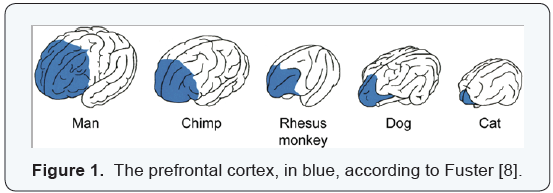
The prefrontal cortex of the brain is compared to that of the
chief executive officer of an organization by Mateer CA et al. [8].
“Imagine the role of the executive officer of a large company, who
has overriding control over the company’s action. This person
sets goals, plans and organizes company activities to meet these
goals, and decides when to start to do something, when to stop
doing it, when to do something else, and when to do nothing at
all... At a basic level, this is what the prefrontal cortex does for
humans.”
In 1848 a construction foreman, Phineas P. Gage, suffered
from an explosion that sent an iron rod through his brain.
After the rod was removed, he turned from “the most efficient
and capable man” into one with new personality traits: “fitful,
irreverent… capricious and vacillating… he had the animal
passions of a strong man.” So reports the neuroscientist Antonio
Damasio in “Decartes’ Error: Emotion, Reason, and the Human
Brain” [9]. Hanna Damasio studied Gage’s skull and found that
it must have been the frontal lobe that was hurt. According
to a more recent but similar case, studied by Paul Eslinger &
Damasios [10] “the frontal lobe of the brain was damaged by
a tumor that was removed, resulting in a turn of the patient’s
emotional reactivity and in impaired ability to reach decisions
though retaining a normal intellect. Such cases show that
some part of the frontal lobe of the human brain is involved in
emotion, reason, and decision-making” [Damasio A 9]. See also
the classical work of [Brenda Milner] on removal of parts of the
frontal lobe of humans. Milner also studied a patient who had
amnesia as a result of a bilateral surgical ablation of parts of
the hippocampus (Scoville and Milner 12). After death of the
patient his brain was examined in detail based on histological
scanning; besides lesions in the hippocampus, a small lesion in
the orbitofrontal cortex was found (Annese et al. 13).
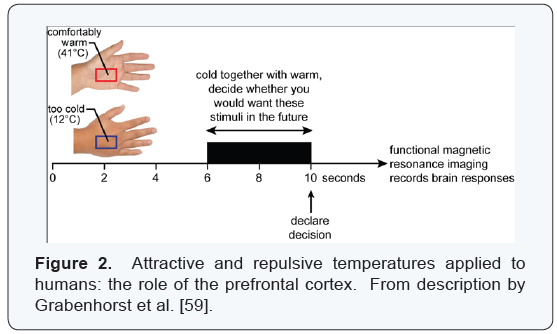
One function of the prefrontal cortex in humans and other
primates is decision making, as reviewed by Jonathan Wallis
[14]. An example of the role of the prefrontal cortex in human
decision-making is provided by the research of the brain
scientist Edmund Rolls et al. [15]. They used functional magnetic
resonance imaging to measure the response when a person’s
hand was exposed to pleasant warmth or unpleasant cold or the
two together (Figure 2). When the two were applied together
and the subject was asked to decide if he/she would want that
again if it were available in the future, there was a response in
the prefrontal cortex, but with either stimulus alone, or with the
two together without needing a decision, responses were only
elsewhere in the brain. In further experiments these authors
came to a similar conclusion when an attractive odor was pitted
against a repulsive odor, again in humans [Rolls ET et al. 16].
Another function of the prefrontal cortex in humans and
other primates is working memory: knowing what to do even
when the stimulus for doing it is removed. “Working memory,”
reported Patricia Goldman & Rakic [17] “is the term applied to
the type of memory that is active and relevant only for a short
period of time, usually on the scale of seconds. A common
example of working memory is keeping in mind a newly read
phone number until it is dialed and then immediately forgotten.”
For a review of working memory in primates see Postle BR [18].
See [Kandel ER 19] for a review of prefrontal cortex and working
memory.
What is in Charge of the Behavior of “Simpler” Animals?
The Boss and executive function have not been reported in
“simpler” animals so far.
The animal behaviorist in “Animal Minds: Beyond Cognition
to Consciousness” Donald Griffen [20] presented evidence that all
animals have mentality, and he developed the idea that zoologists
should investigate questions of animal consciousness. He used
examples from vertebrates such as dolphins and birds and from
invertebrates such as honeybees. But plants and protists are not
eligible, Griffin says “... animals are also clearly more than mobile
metabolisms. They act [sic], that is they do things spontaneously,
on their own. The complexity... distinguishes them in an
important fashion from microorganisms, plants, and physical
systems.… Since protozoa lack anything at all comparable to
a central nervous system capable of storing and manipulating
information, it seems highly unlikely that they could be capable
of anything remotely comparable to conscious thinking.”
The central complex of insects is required for sensing
attractants and repellents (Figure 3). The central complex is
related to the mammalian brain (Figure 4). They are derived
from a common ancient ancestor. ,Drosophila mutants have
been isolated Vang & Adler [24] that failed to be attracted by
anything tested (Figure 5) and failed to be repelled by anything
tested, even though they are motile. They have a defect in the mechanism that dictates a behavioral response.
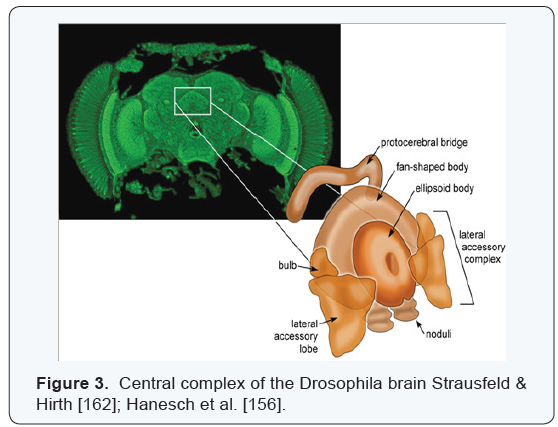
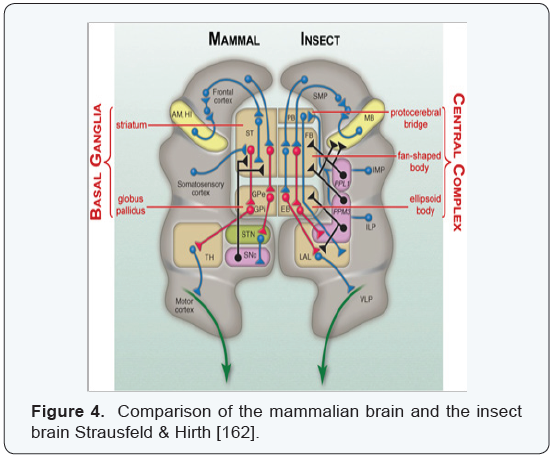
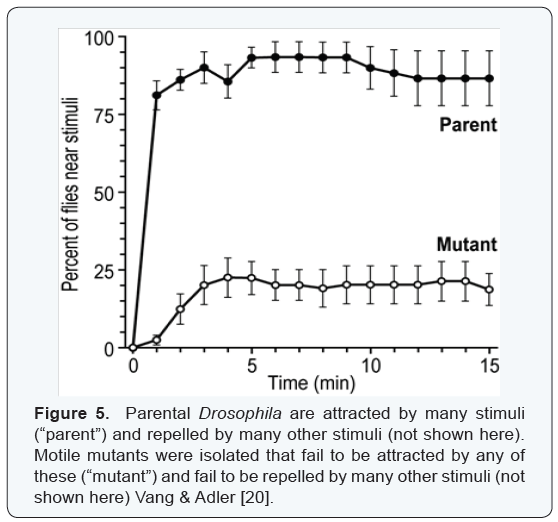
Decision making, a function of the prefrontal cortex in people
and other primates, has been found in Drosophila, too According
to Alder. The flies at one end of a tube largely refused to go to
the other end containing attractant together with overpowering
repellent, but mutants could be isolated which did go there.
These mutants presumably had a defect in deciding what to do.
Analogous to the prefrontal cortex in humans and other
primates, the central complex of the fly is presumed to be in
control of behavior. Some thirty Drosophila mutants defective in
the fly’s central complex have been isolated by Richard Strauss
& Martin Heisenberg [26], Kirsa Neuser et al. [27], Joanna Young
& Douglas Armstrong [28], and others. We found that three of
these are defective in bringing about behavioral responses Vang
& Adler [24]. Using them, one can learn how the central complex
generates a behavioral response.
Working memory, a part of the prefrontal cortex first
described in people and other primates, has now been found in
insects, too. This was discovered by Roland Strauss et al. [27],
who showed that Drosophila can remember the position of an
object for several seconds after the object has been removed, as
illustrated in (Figure 6). By using mutants, the authors [27] found
that this behavior depends on ring neurons of the ellipsoid body
in the brain’s central complex.
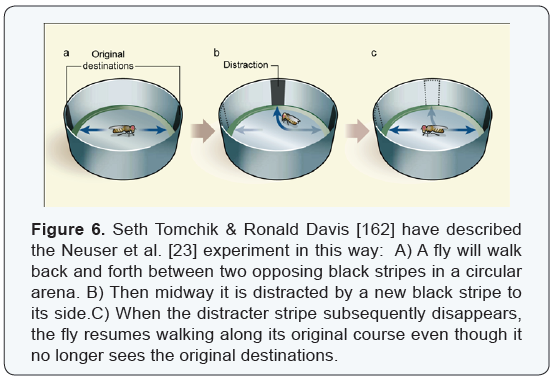
Charles Darwin’s study of the behavior and intelligence of
earthworms is presented in his 1881 book, “The Formation of
Vegetable Mould, through the Action of Worms with Observations
on Their Habits.” [29] Earthworms plug the openings of their
burrows with leaves. Darwin did experiments to study the
worm’s reactions to variation in the shape of the leaves, for
example he used cut leaves, pine needles, and “leaves” made from
paper. He showed that the worm feels the shape of the leaves
prior to grasping them and that it used judgment about the best
way to pull the leaves into their burrow. Darwin said: “If worms
have the power of acquiring some notions, however crude, of
the shape of an object and of their burrows as seems to be the
case, they deserve to be called intelligent; for they act in nearly
the same manner as would a man under similar circumstances… One alternative alone is left, namely that worms, although
standing low in the scale of organization, possess some degree
of intelligence; this will strike every man as very improbable, but
it will be doubted whether we know enough about the nervous
system of the lower animals to justify our natural distrust of
such a conclusion”.
What is in Charge of the Behavior of a Plant?
Evidence for The Boss and executive function in plants
has not been presented, but it could be implied by some of the
following work.
Studies by Charles Darwin and his son Francis on the behavior
of plants, reported in 1881 in their book, “The Power of Movement
in Plants”, led them to conclude, “Finally, it is impossible not to be
struck with the resemblance between the forgoing movements of
plants and many of the actions performed unconsciously by the
lower animals ... Yet plants do not of course possess nerves or a
central nervous system; and we may infer that as with animals
such structures serve only for the more perfect transmission of
impressions and for the more complete intercommunication of
the several parts...We believe that there is no structure in plants
more wonderful as far as its functions are concerned than the
tip of the radicle [the root] ... It is hardly an exaggeration to say
that the tip of the radical thus endowed, and having the power
of directing the movements of the adjoining parts, acts like the
brain of the lower animals” [26].
The plant physiologist Wilhelm Pfeffer [27] stated in his
book “The Physiology of Plants”: “The fact that in large plants the
power of growth and movement are not strikingly evident has
caused plants to be popularly regarded as ‘still life’. Hence the
rapid movements of sensitive Mimosa pudica were regarded as
extraordinary for a plant… If mankind from youth upwards were
accustomed to view nature under a magnification of 100 to 1000
times, or to perceive the activity of weeks or months performed
in a minute, as is possible with the aid of a kinematograph, this
erroneous idea would be entirely dispelled” Pfeffer W [27].
Pfeffer studied the “behavior” of plants, both rapid catching
of insects and also slow growth-responses to environmental
stimuli, called tropisms.
Jagadish Chandra Bose was first a physicist, working on
electromagnetic radiation, then he spent thirty years studying
electrical signaling in plants. His major conclusion, presented
in “The Nervous Mechanisms of Plants” in 1926: “Ordinary
plants, meaning those usually regarded as insensitive, exhibit
the characteristic electric response already known in ‘sensitive’
plants. Ordinary plants were regarded at the time as inexcitable,
because they did not respond to stimulation by an obvious
movement … I was, however, able to show that every plant,
and even each organ of every plant, is excitable and responds
to stimulus by electric response of galvanotropic negativity …
The most important fact established in plant-response was the
nervous character of the impulse transmitted to a distance. My
discovery of the excitatory polar action of an electric current and its
transmission to a distance, proved that the conduction of
excitation in the plant is fundamentally the same as that in the
nerve of an animal” Bose [28].
Action potentials in plants have been extensively studied,
see for example those of the Venus fly trap, the touch-sensitive
Mimosa, and pea, as described by Clifford Slayman [29] and
reported by Michael Sussman [30] thus action potentials occur
in both carnivorous and non-carnivorous plants, but they are
slower than those of the squid giant axon.
In “Plant neurobiology: an integrated view of plant
signaling”, Eric Breuner [31] reviewed the evidence that the
behavior which plants exhibit is coordinated across the whole
organism by some form of integrated signaling, communication,
and response system. Studies of the neurobiology of plants
have been stimulated by the creation of the Society for Plant
Neurobiology; in its 2006 symposium book, “Communication in
Plants: Neuronal Aspects of Plant Life”, František Baluška et al.
[32] and Peter Barlow say, “Roots represent the essential part of
the plant whereas shoots can be dispensable … Each root apex
is proposed to harbour brain-like units of the nervous system of
plants ... All ‘brain units’ are interconnected via vascular strands
(plant neurons) with their polarly-transported auxin (plant
neurotransmitter), to form a neuronal system of plants” [32].
The Society in 2009 was renamed “The Society of Plant Signaling
and Behavior” and its journal was renamed “Plant Signaling and
Behavior.”
Daniel Chamovitz [33] published “What a Plant Knows, a
Field Guide to the Senses” to review a plant’s equivalent of our
senses: what a plant sees, smells, feels, etc. As an example,
Chamovitz reviews how the parasitic not-green dodder plant
locates its prey: it grows toward a certain chemical given off by a
green plant such as the tomato and away from another chemical
given off by a different green plant such as wheat, according to
Consuelo De Moraes et al. [34]. But Chamovitz rejects the idea
that plants are a subject for neurobiology [33].
What is in Charge of the Behavior of a Microorganism?
Evidence for The Boss and executive function in
microorganisms has not been shown, but it could be implied
in some of the following work. The physiologist Max Verworn,
who studied unicellular organisms and nerve cells, wrote in
1889 in his book, “Psycho-Physiologische Protisten-Studien”:
“My dear professor! When under your guidance I began my
instruction in zoology, it was from the very beginning the life
of the lowest organisms that interested me the most. For here,
on the lowest level of life, within the framework of one single
cell, all the phenomena of life which we observe in the higher
organisms can be found in their most simple form … To be sure
some physiologists do not yet recognize psychology as part of
physiology; yet if physiology considers the investigation of the
phenomena of life to be its task, then the consequences of this
conception is obvious, for the psychic processes are just as well
phenomena of all life as are the metabolism processes” Verworn [35]. Eukaryotic microorganisms and bacteria were included in
Verworn’s studies.
The behavior of microorganisms was reviewed by Alfred
Binet [36], the father of the IQ test, in his book “The Psychic
Life of Micro-organisms, a Study in Experimental Psychology”: “I
have endeavored in the following essay upon micro-organisms
to show that psychological phenomena begin among the very
lowest classes of beings; they are met with in every form of life,
from the simplest cellule to the most complicated organism. It
is they that are the essential phenomena of life, inherent in all
protoplasm... Thus, even on the lowest rounds of the ladder of
life, psychic manifestations are very much more complex than is
usually believed”. Eukaryotic microorganisms and bacteria were
included in Binet’s review.
Motile cells of animals have been studied: for example
leukocytes, which are amoeboid cells of the immune system, by
Martha Cathcart [37] and Connie Wong et al. [38]; and flagellated
sperm interacting with egg, by Roy Kaplan et al. [39].
In the yeast Saccharomyces cerevisiae two haploid cells of
opposite mating type, a and @, fuse by a chemotropic response
to their pheromomes Cross, Hartwell et al. [40]. The mechanism
of this fusion is being studied by use of mutants that fail here
Arkowitz [41], Gelin-Licht [42].
Discostelium discoideum are social amoebae whose behavior
has been studied by Peter Devreotes and others Swaney [43].
These cells depend on chemotaxis to find food and to survive
starvation conditions. Their movement relies on the extension
of pseudopods. Mutants missing various components have been
isolated and studied.
The behavior of the ciliated protozoan Paramecium was
placed on a mechanistic basis by the research of Herbert
Jennings [44], Yutaka Naitoh & Roger Eckert [45], and Boris
Martinac, Yoshiro Saimi & Ching Kung [46]. It was shown that
the movement of Paramecium is regulated by electrical events
caused by the flow of ions such as potassium and calcium, and
that there is a genetic basis for this movement.
Engelmann discovered in 1881 that bacteria are attracted
to light (“phototaxis”) Engelmann [47], and in the archaeon
Halobacterium salinarum the role of microbial rhodopsin
in phototaxis is now biochemically described Spudich [48].
Wilhelm Pfeffer [49] discovered in that bacteria are attracted
and repelled by various chemicals (“chemotaxis”), and in
the bacterium Escherichia coli a biochemical mechanism for
chemotaxis has been summarized Adler [50], Hazelbauer [51],
Crooks et al. [52]. Gliding motility and multicellular swarming
in the bacterium Myxococcus xanthus has been studied by Dale
Kaiser and by “David Zusman [53].
How Behavior is Controlled
For organisms in general, the mechanism of behavior and
the control of behavior are summarized in Figure 7. There are
sensory inputs, both for external and internal stimuli. Then the organism chooses what to do about these by means of decision
making. That result is then sent to the final pathway, which
dictates a behavioral response. Decision making is directed by
executive function which in turn is influenced by The Boss.
The interaction between stimuli and decision making (Figure
7) has been studied/reported by Marcus Raichle [54,55], Dennis
Bray [56], Björn Brembs [57] and Axel Gorostiza, Julien Colomb &
Björn Brembs [58]. There is an active state that is present before
stimuli are presented, then a different state upon presentation
of stimuli. Although discovered in mammals Marcus Raichle
[54,55], such a phenomenon occurs also in invertebrates and
bacteria Dennis Bray [56]. A decision-making process has been
reported by Alex Gorostiza, Julien Colomb & Björn Brembs [58].
Here are examples of decision making in the case of attractant
together with repellent: in people Grabenhorst et al. [59], see
(Figure 2); Rolls et al. [60]; dogs Andersson et al. [61]; insects
Dethier [62], Tang & Guo [63], Zhang et al. [64], Yang et al. [65],
Joseph et al. [66], Vang et al. [67], Adler & Vang [20] ; worms
Ishihara et al. [68]; plants Liscum & Briggs [69], Hangarter [70];
and bacteria Tsang et al. [71], Adler & Tso [72], Schultz et al. [73].
These can be viewed as valuable for trying to find out if a study
of conflicting behavior might yield information about executive
function.
Especially valuable will be those cases above where it has
been possible to isolate mutants that could involve a defect in
decision making or in executive function and perhaps even in
The Boss Tang & Guo [63], Ishihara et al. [68], Vang et al. [67],
Zhang et al. [64], Yang et al. [65], Joseph et al. [66], Adler & Vang
[20].
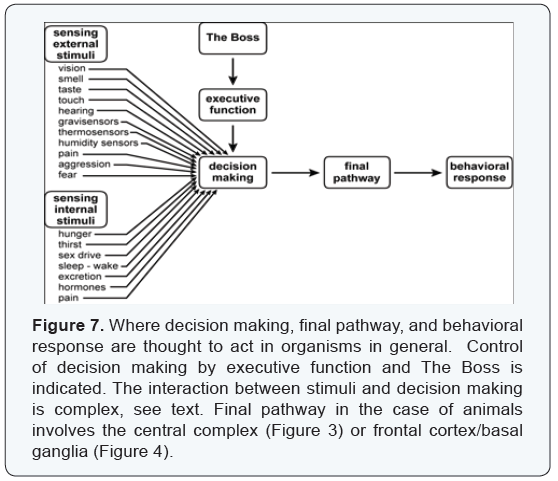
When there is a change in environment or a change internally,
The Boss determines what is needed to compensate, and then
executive function carries this out by way of decision making
(Figure 7). For example, a bad taste may prevent an organism
from consuming a needed substance, but if the organism is
starved for that substance The Boss can change the system so that the valuable substance is anyway consumed. How that is
achieved is presently unknown.
An example of change is shown in Figure 8, where a
Drosophila mutant changed its property over a 20 day period:
as it aged, the response changed: the mutant became attracted
to attractant plus overpowering repellent where previously it
was repelled Adler & Vang [20]. What is the mechanism for such
a change? That needs to be discovered. In people, Altzheimer’s
disease is such an age-dependent behavioral change that needs
to be understood Selkoe et al. [74].
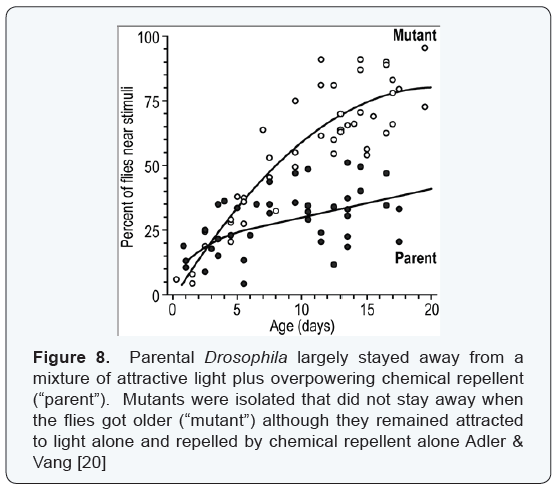
Metabolism and its Control
At first scientists learned about small molecules (for example
glucose) and then about enzymes, then it became known that
there are genes that made the enzymes, and now mechanisms
are known that control the genes. Initially specific controls were
discovered, like the operon that is in charge of the metabolism
of lactose Jacob & Monod [75], Beckwith [76]. Then it was
found that related operons could be controlled by a common
regulator, the regulon Neidhardt [77], Beckwith [76], Neidhardt
& Savageau [78]. Sets of operons are coordinately controlled by
global regulators, as described by Susan Gottesman [79]. The
global regulators of E. coli evident by 2003 have been reviewed
by Augustino Martinez-Antonio & Julio Collado-Vides [80], see
their figure reproduced here (Figure 9), which tells that there
are seven global regulators that are sufficient for modulating
the expression of 51% of the genes in E. coli. Thus a few global
regulators have a large influence.
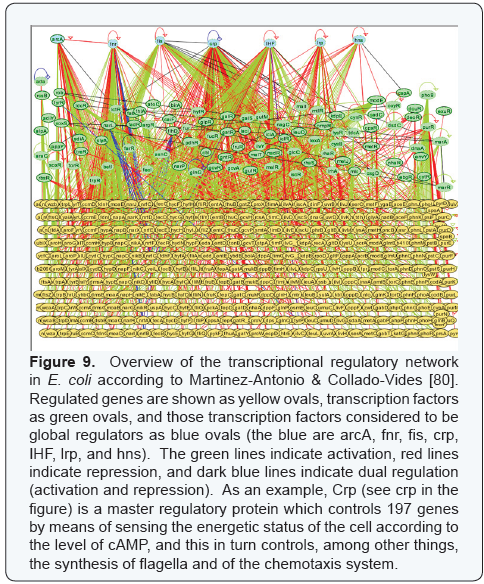
CsrA is a bacterial global regulator. Tony Romeo et al.
[81] showed that CsrA, an RNA binding protein, can interact
with RNAs of at least 721 genes. Some of these RNAs function
positively to make the enzymes needed for the growth phase and
some function negatively for inhibition of these enzymes in the
approach to stationary phase.
Some further examples of global regulatory pathways
follow. In the case of response to stress, E. coli represses its
housekeeping genes and turns on genes for handling noxious
conditions such as heat, a high salt concentration, radiation by
ultraviolet light, acidic pH, and ethanol, have reported Gruber
TM & Gross CA [82]. It does this by replacing the sigma factor for
turning on housekeeping genes with sigma factors for turning
on genes that mediate the emergency, thus regulating 225 genes
– 203 positively and 22 negatively according to Tao Dong &
Herb Shellhor [83]. Similarly, upon exposure to heat, hydrogen
peroxide, or a high salt concentration, yeast represses about 600
genes related to synthesis of normally required proteins and
induces about 300 other genes needed for the stress response,
according to Audrey Gasch et al. [84]. This occurs partially
through changes in chromatin brought about by means of
deacetylation of histones in both coding and non-coding regions.
In a systems biology approach, Andrew Joyce & Bernhard
Palsson [85] have shown that one can interpret genomic results
to indicate that certain components are global regulators and
others are genes for enzymes that are targets. They illustrate 104
regulators of E. coli that control 479 genes for target enzymes.
Covert MW et al. [86] says, “We expect that after an effort of some
years and many iterations of this process, regulatory network
elucidation for E. coli will be essentially complete.” At that time
one will be able to tell which components control all the rest.
Development and its Control
In the case of development, the hox genes of an embryo
act to regulate genes that in turn regulate large networks of
other genes; for example in Drosophila the hox genes regulate
the genes that form the organs of each segment, including the genes that form appendages, according to William McGinnis and
collaborators Pearson et al. [87].
Also in development, there is a general transcription factor,
Lola, that regulates axon pathfinding in the Drosophila embryo.
Edward Giniger, Liqun Leo, and collaborators have shown that
the lola gene controls some of the earliest steps of development
as well as later stages Spletter et al. [88]. This gene, which by
alternative splicing makes 20 isoforms, regulates the expression
of at least 1,000 to 1,500 other genes Gates [89]; unpublished
data of Edward Giniger. Thus lola was called a “master regulator”
by Giniger and coworkers: it orchestrates the appropriate
expression of guiding factors, receptors, and signaling proteins
that execute the guidance decisions of a given growth cone
Madden et al. [90].The involvement of RNA in development has
been studied by Scott Aoki et al. [91].
Immunological Response and its Control
In the case of immunological responses, it is the synthesis
of lymphocytes from stem cells that is globally regulated. This
regulator is Early B-cell Factor acting by way of Pax5, which
is a transcription factor that activates 170 appropriate genes
and represses 110 inappropriate genes, as documented by
Cobaleda C et al. [92] and Lukin K et al. [93]. This action results
in commitment to making the lymphocytes.
Reproduction and its Control
Mating in bacteria (“conjugation”) is the transfer of genetic
material from a “male” into a “female” bacterium. This was
discovered by Joshua Lederberg & Edward Tatum [93] and has
been further studied to the present time Gomis-Rüth et al. [94].
In animals sex steroids are crucial for reproduction Guerriero
[95]. In plants Sun Y et al. [96] and in bacteria Bode et al. [97]
such steroids also occur but any function in reproduction is not
yet determined.
For reviews see, Bell G [98] The Masterpiece of Nature: The
Evolution and Genetics of Sexuality, Michod RE [99] The Evolution
of Sex: an Examination of Current Ideas, Otto SP, Lenormand
T [100] Evolution of sex: Resolving the paradox of sex and
recombination.
The BOSS
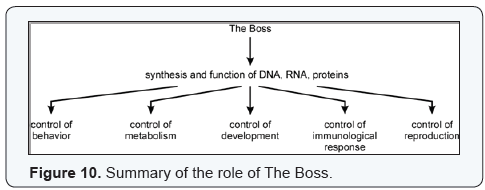
Behavior, metabolism, development, immunological
responses, and reproduction, each discussed above, are
controlled by The Boss. There is one Boss for all these functions.
The Boss is perhaps the same for all organisms. What is The Boss and how does it control? The Boss is an unknown hypothetical
mechanism that directs the synthesis and activity of DNA, RNA,
and proteins and thereby is in charge of behavior, metabolism,
development, immunological responses, and reproduction
(Figure 10).
Essential Genes and the Boss
Now that we know the sequence of deoxynucleotides in the
DNA of many different organisms (humans, rats, mice, fish, flies,
worms, yeast, plants, bacteria, etc.), one can try to find out, for
each organism, which are essential genes. Non-essential and
essential genes are defined in the following way: Elimination
of a non-essential gene (by mutation) still allows the organism
to survive, while elimination of an essential gene (by mutation)
leads to death. Essential genes are shown in (Figure 11). There
are essential genes whose functions are still not fully known.
Their functions need to be determined. And what, if anything,
controls the various essential genes, what turns them on and
off? That itself may be The Boss (Figure 11).
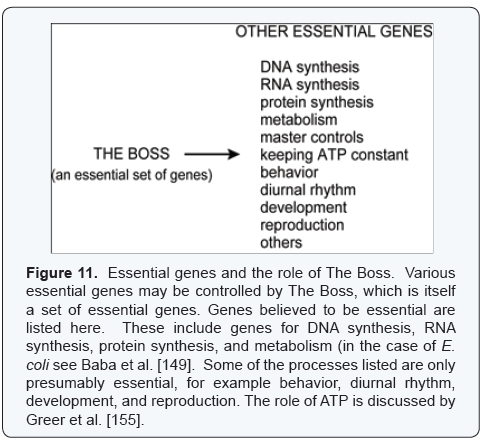
How many essential genes are there? The list of essential
genes has not yet been completed in humans [total number of
genes 20,000-25,000] International Human Genome Sequencing
Consortium [101], in mice [total 20,00-25,000] Mouse Genome
Sequencing Consortium [102], in zebra, fish [total about 25,000]
Herrero et al. [103], and in Arabidopsis [total about 26,000]
Arabidopsis [104] Genome Initiative, but in Drosophila there are
about 3,700 essential genes out of a total of 13,379 genes Adams
et al. [105], in C. elegans about 5,700 out of 19,427 C. elegans
Sequencing Consortium [106], in Saccharomyces cerevisiae
1,105 out of 5,916 Giaver et al. [153], in E. coli 303 out of 4,377
Yamamoto, Riley et al. [107], in Mycoplasma genitalium 382 out
of 482 Glass et al. [108].
The fact that E. coli has so few essential genes (303 of them),
compared to a much larger number in eukaryotes, makes the search for The Boss seemingly easier in E. coli. Finding out which
of the essential genes in E. coli, and in other organisms as well,
controls behavior, metabolism, development, immune response,
and reproduction, and determining how The Boss might control
those essential genes, is one way for identifying The Boss.
Synthesis of DNA, RNA, and Protein in Relation to the Boss
Our knowledge of how DNA, RNA, and proteins are made,
and how this is controlled, is now extensive for DNA synthesis
Kaguni [109], Zakrzewska-Czerwinska et al. [110], Katayama et
al. [111] and Masai et al. [112] for RNA synthesis including the
spliseosome Wahl et al. [113], Jackson et al. [114], Malys & Mc
Carthy [115], and Nakagawa et al. [116], Hoskins & Moore [117],
and for protein synthesis Thomas & Chiang [118], Passalacqua
et al. [119], Jiang & Pugh [120], Sorek & Cossart [121], and Kim
& Park [81]. As an example, there is a time during the cell cycle
when DNA synthesis is turned on and a time when it is turned
off. The proposal here is that there is a master control, The Boss,
that dictates what shall be the state of synthesis of DNA, RNA,
and proteins.
A remarkable discovery, made by Burton et al. [122] and
by Lupski et al. [123], is the existence of an operon in E. coli
that directs all three of the most essential components of an
organism: DNA (dnaG, which makes DNA primase), RNA (rpoD,
which makes a part of RNA polymerase), and protein (rpsU,
which makes a part of ribosomes). How is this dnaG-rpoDrpsU
operon turned on and off? It seems likely that The Boss
may control it. We are trying to obtain Boss mutants that fail
in control of the dnaG-rpoD-rpsU operon. Links between DNA
replication and RNA synthesis and between DNA replication and
protein synthesis have already been proposed Chiaramello &
Zyskind [124], Schreiber et al. [125], Wang et al. [126], Ferullo &
Lovett [127], and Berthon et al. [128].
DNA other than Protein-Coding Genes
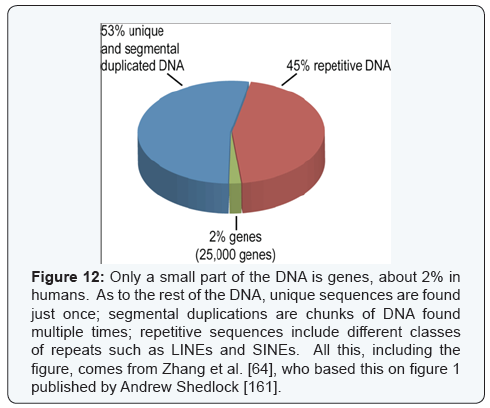
Bacteria and eukaryotes have very roughly a similar number
of genes that code for proteins (400 to 5,000 for bacteria and
about 6,000-25,000 for eukaryotes) but in bacteria most of the
DNA is genes that code for proteins while in eukaryotes the DNAcoding
genes are only a small part of the DNA. For example, in
mammals it is only 1-2% Mercer et al. [129], see (Figure 12).
The amount of DNA/cell in bacteria is about 3-4 million
base pairs/cell, about 12 million in yeast, about 180 million in
flies, and about 3 billion in humans, in accord with approximate
complexity (although some amphibians have 25 times as much
DNA as human cells) Moore [130], Darnell [131].
Recently workers have shown that 70 to 90 percent of the
eukaryotic DNA produces RNAs which do not make proteins
and don’t end up being ribosomal RNA, transfer RNA, or known
control RNA Mercer et al. [129], Nagalakshmi et al. [132], Wang
et al. [133], Ozsolak et al. [134]. Some of such RNAs occur also
in prokaryotes Sorek & Cossart [121], Siezen et al. [135] Thus a
large part of the DNA in eukaryotes makes RNAs that control the
organism in unknown ways. How such RNAs function is currently
being investigated, both in eukaryotes Wang et al. [133], Ozsolak
et al. [134] and in prokaryotes Sorek & Cossart [121], Siezen et
al. [135]. These studies all point to non-coding RNA as a source
of regulatory elements Carninci & Hayashizaki [136].
Thus the biological complexity of organisms is not reflected
merely by the number of protein-making genes but by the number
of other physiologically relevant interactions, say Michael Stumpf
et al. [137]. The whole set of molecular interactions in cells has
now become known as the “interactome”; this includes protein-
DNA interactions, protein-RNA interactions, and protein-protein
interactions, according to Sanchez C et al. [138]. Such interaction
maps have been presented for Drosophila by Sanchez C et al. [138]
and by Giot et al. [139]. The size of interactomes correlates much
better with their apparent biological complexity than does the
size of the genome; thus the number of interactions in humans is
estimated to be about 650,000 compared to about 25,000 genes
in the human genome, say Stumpf MPH et al. [137]. While much
progress has been made in describing interactomes, we are still
far away from completion because the interactome considers the
whole organism and thus there is the need to collect a massive
amount of information.
A novel method for studying regulators of transcription is
chromatin immunoprecipitation (ChIP, also ChIP-chip) studied
by Mooney RA et al. [140]. By this method, formation of a complex
between DNA and proteins can now be studied on a global scale
by isolating the complexed part, precipitating it with antibody
to the protein, then identifying the DNA portion. This method
has been successfully used in humans, other animals, yeast and
bacteria. The results tell that certain parts of the DNA interact
with transcription factors and with sigma factors that allow RNA
synthesis to take place. In short, the regulatory parts of the DNA
are being identified by this method. A different method focuses on the interplay between transcription factors and microRNAs,
studied by what is called the “yeast one-hybrid (Y1H)” method;
this work is also being widely pursued and especially by Marian
Walhout’s group in C. elegans Martinez NJ & Walhout JM [141].
OK, there are regulators in charge of many functions. Do the
regulators act independently of each other, or is there something
that controls them? It seems that independent function of
each regulator would result in competition and confusion
incompatible with the life of the organism. Something must be
coordinating them. It is The Boss. But that is only an idea at this
time.
Chemistry of the Boss
What is The Boss? Of course it must be a gene or genes
and it must be essential (Figure 11). The gene(s) for The Boss
would seem to be made of DNA, but not necessarily, as any other
inheritable material would work. Since RNA may have been
present in organisms before there was any DNA, according to
ideas of Carl Woese (142), David Baltimore (143), Walter Gilbert
(144), and Raymond F, Gesteland & John F. Atkins (145) Gerald
Joyce (146), Jennifer Doudna & Thomas Cech (147) and since
The Boss may already have occurred in these earliest organisms,
the Boss genes might well be RNA that does not go through any
DNA at all, like many of the known RNA viruses Woese [142].
Latique C et al. [148] have successfully put an intact DNA
genome isolated from one species of bacterium into another
species, and their current work aims to do this transformation
with a DNA genome that they have chemically synthesized
Gibson DG et al. [149]. This work does not, however, rule out
that The Boss is RNA independent of DNA or that it is any other
inheritable material, since the recipient bacterium in their
experiments contains all the non-DNA components of a cell.
Use of Mutants to identify the Boss
As described in II. A. 5, behavioral mutants that could
possibly be defective in executive function and perhaps even in
The Boss may have been isolated. One can also try to isolate such
mutants that are defective in metabolism, development, immune
response, and reproduction, and perhaps even in The Boss. The
control of any essential gene by The Boss (Figure 11) could be
studied by obtaining mutants that fail there.
Summary
- The behavior of various organisms – people and other primates, “simpler” animals, plants, microorganisms – has been reviewed and its direction by executive function and The Boss has been suggested:
- The role of global regulators directing metabolism has been reviewed.
- The role of master regulators directing development has been discussed.
- The control of immunological response has been discussed.
- The control of reproduction has been discussed.
- The idea that each organism is under control by The Boss has been presented. It is proposed that The Boss is in charge of the organism by way of controlling behavior, metabolism, development, immune response, and reproduction, as shown in (Figure 10).
- Synthesis of DNA, RNA, and proteins has been discussed in relation to The Boss (Figure 10).
- Essential genes have been discussed in relation to finding The Boss (Figure 11).
- DNA other than that which codes for synthesis of proteins has been discussed in relation to The Boss (Figure 12).
- As to the chemistry of The Boss, this is unknown. It could be DNA, or it could be RNA that functions independently of DNA.
- Genetic studies of The Boss and the control of behavior, metabolism, development, immune response, and reproduction will be carried out further.
Alternative Views
The Boss is a hypothetical entity; there is little or no evidence
for it at this time.
An alternative is that there is no central boss at all but
instead there is a different boss for each of the five parts.
Another alternative is that it doesn’t require any boss at all to
get interaction between behavior, metabolism, development,
immune response, and reproduction. Each of these may interact
with each other but without any control by a boss. So it is possible
that there is no boss. There is no evidence to support any of these
above alternatives at this time. It will require further research to
determine which of these ideas (if any) is correct.
Acknowledgement
For valuable criticisms here (some of it devastating), I thank
Buzz Baldwin, Dale Kaiser, Ching Kung, Bob Lehman, David
Nelson, and Sandy Parkinson, and also the members of my
laboratory. I especially thank Lar Vang for discussions. Some of
the research on Drosophila and on E. coli presented here was
carried out by recent and current undergraduate students. I am
most grateful to The Camille and Henry Dreyfus Foundation for
supporting our research by undergraduates the past six years by
means of their Senior Scientist Mentor Program. I thank Laura
Vanderploeg for beautiful artwork.
For
more Open Access Journals in Juniper Publishers please
click on: https://juniperpublishers.com
For more articles in Anatomy Physiology & Biochemistry International Journal please click
on: https://juniperpublishers.com/apbij/index.php
For more Open Access Journals please click on: https://juniperpublishers.com
To know more about Juniper Publishers please click on: https://juniperpublishers.business.site/
For more articles in Anatomy Physiology & Biochemistry International Journal please click
on: https://juniperpublishers.com/apbij/index.php
For more Open Access Journals please click on: https://juniperpublishers.com
To know more about Juniper Publishers please click on: https://juniperpublishers.business.site/



Comments
Post a Comment